实验5 C语言指针应用编程
task1_1
1 #include <stdio.h> 2 #define N 5 3 4 void input(int x[], int n); 5 void output(int x[], int n); 6 void find_min_max(int x[], int n, int *pmin, int *pmax); 7 8 int main() { 9 int a[N]; 10 int min, max; 11 12 printf("录入%d个数据:\n", N); 13 input(a, N); 14 15 printf("数据是: \n"); 16 output(a, N); 17 18 printf("数据处理...\n"); 19 find_min_max(a, N, &min, &max); 20 21 printf("输出结果:\n"); 22 printf("min = %d, max = %d\n", min, max); 23 24 return 0; 25 } 26 27 void input(int x[], int n) { 28 int i; 29 30 for(i = 0; i < n; ++i) 31 scanf("%d", &x[i]); 32 } 33 34 void output(int x[], int n) { 35 int i; 36 37 for(i = 0; i < n; ++i) 38 printf("%d ", x[i]); 39 printf("\n"); 40 } 41 42 void find_min_max(int x[], int n, int *pmin, int *pmax) { 43 int i; 44 45 *pmin = *pmax = x[0]; 46 47 for(i = 1; i < n; ++i) 48 if(x[i] < *pmin) 49 *pmin = x[i]; 50 else if(x[i] > *pmax) 51 *pmax = x[i]; 52 }
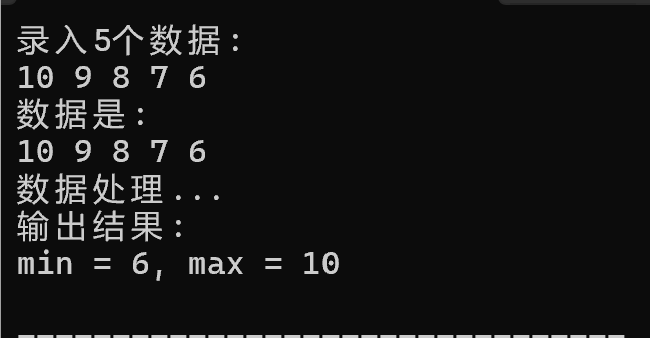
用文字回答问题:
1. 函数 find_min_max 实现的功能是找到这组数据中的最大值与最小值
2. "指针变量在使用之前必须指向确定的地址"。执行到line45时,指针变量pmin、pmax均指向数组x[0]的地址
task1_2
1 #include <stdio.h> 2 #define N 5 3 4 void input(int x[], int n); 5 void output(int x[], int n); 6 int *find_max(int x[], int n); 7 8 int main() { 9 int a[N]; 10 int *pmax; 11 12 printf("录入%d个数据:\n", N); 13 input(a, N); 14 15 printf("数据是: \n"); 16 output(a, N); 17 18 printf("数据处理...\n"); 19 pmax = find_max(a, N); 20 21 printf("输出结果:\n"); 22 printf("max = %d\n", *pmax); 23 24 return 0; 25 } 26 27 void input(int x[], int n) { 28 int i; 29 30 for(i = 0; i < n; ++i) 31 scanf("%d", &x[i]); 32 } 33 34 void output(int x[], int n) { 35 int i; 36 37 for(i = 0; i < n; ++i) 38 printf("%d ", x[i]); 39 printf("\n"); 40 } 41 42 int *find_max(int x[], int n) { 43 int max_index = 0; 44 int i; 45 46 for(i = 1; i < n; ++i) 47 if(x[i] > x[max_index]) 48 max_index = i; 49 50 return &x[max_index]; 51 }
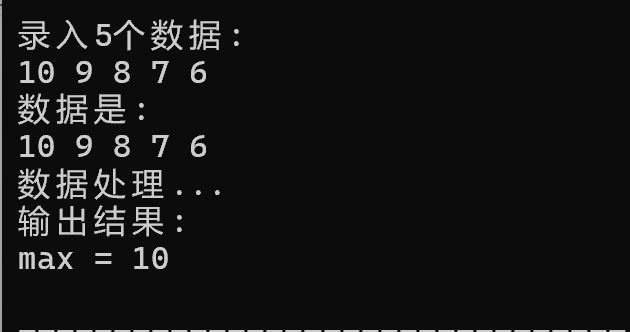
用文字回答问题:
1. 函数 find_max 的功能是找到最大数据对应的地址,返回值是一个地址,在主函数中利用“*”间接访问,得到最大值
2. 把函数 find_max 的实现写成以下代码,可以,可以找到这组数据的最大值
task2
1 #include <stdio.h> 2 #include <string.h> 3 #define N 80 4 5 int main() { 6 char s1[] = "Learning makes me happy"; 7 char s2[] = "Learning makes me sleepy"; 8 char tmp[N]; 9 10 printf("sizeof(s1) vs. strlen(s1): \n"); 11 printf("sizeof(s1) = %d\n", sizeof(s1)); 12 printf("strlen(s1) = %d\n", strlen(s1)); 13 14 printf("\nbefore swap: \n"); 15 printf("s1: %s\n", s1); 16 printf("s2: %s\n", s2); 17 18 printf("\nswapping...\n"); 19 strcpy(tmp, s1); 20 strcpy(s1, s2); 21 strcpy(s2, tmp); 22 23 printf("\nafter swap: \n"); 24 printf("s1: %s\n", s1); 25 printf("s2: %s\n", s2); 26 27 return 0; 28 }

回答问题:
问题1:数组s1的大小是24, sizeof(s1) 计算的是该字符数组占用的空间字节数, strlen(s1) 统计的是字符串字符个数。
问题2:line6代码,不能替换成以下写法,原因:
1.第一列,单独定义一个字符数组时,要有常量大小
2.第二列,不能将一个数组赋值给一个地址常量
问题3:line20-22执行后,字符数组s1和s2中的内容交换
task2_2
1 #include <stdio.h> 2 #include <string.h> 3 #define N 80 4 5 int main() { 6 char *s1 = "Learning makes me happy"; 7 char *s2 = "Learning makes me sleepy"; 8 char *tmp; 9 10 printf("sizeof(s1) vs. strlen(s1): \n"); 11 printf("sizeof(s1) = %d\n", sizeof(s1)); 12 printf("strlen(s1) = %d\n", strlen(s1)); 13 14 printf("\nbefore swap: \n"); 15 printf("s1: %s\n", s1); 16 printf("s2: %s\n", s2); 17 18 printf("\nswapping...\n"); 19 tmp = s1; 20 s1 = s2; 21 s2 = tmp; 22 23 printf("\nafter swap: \n"); 24 printf("s1: %s\n", s1); 25 printf("s2: %s\n", s2); 26 27 return 0; 28 }
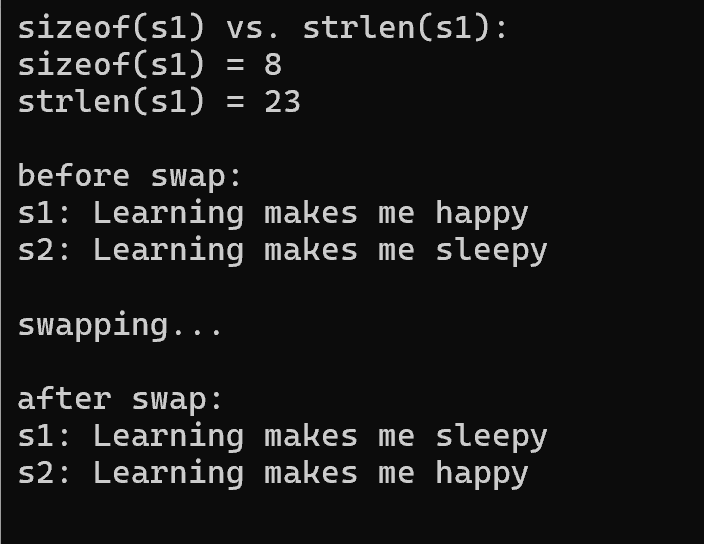
回答问题:
问题1:指针变量s1中存放的是字符串的地址, sizeof(s1) 计算的是指针字符串所占用的内存大小, strlen(s1) 统计的是对应字符串字符个数。
问题2:line6代码可以替换成下面的写法
描述二者的语义区别:二者的区别在于定义与初始化的顺序,下面程序的实现是先定义一个字符指针,再初始化这个指针指向该字符串。
char *s1; s1 = "Learning makes me happy";
问题3:line19-line21,交换的是指针的地址名。
字符串常量"Learning makes me happy"和字符串常量"Learning makes me sleepy"在内存存储单元中没有交换,只是通过改变指针的指向,间接访问。
task3
1 #include <stdio.h> 2 3 #include <stdio.h> 4 5 int main() { 6 int x[2][4] = {{1, 9, 8, 4}, {2, 0, 4, 9}}; 7 int i, j; 8 int *ptr1; // 指针变量,存放int类型数据的地址 9 int(*ptr2)[4]; // 指针变量,指向包含4个int元素的一维数组 10 11 printf("输出1: 使用数组名、下标直接访问二维数组元素\n"); 12 for (i = 0; i < 2; ++i) { 13 for (j = 0; j < 4; ++j) 14 printf("%d ", x[i][j]); 15 printf("\n"); 16 } 17 18 printf("\n输出2: 使用指向元素的指针变量ptr1间接访问二维数组元素\n"); 19 for (ptr1 = &x[0][0], i = 0; ptr1 < &x[0][0] + 8; ++ptr1, ++i) { 20 printf("%d ", *ptr1); 21 22 if ((i + 1) % 4 == 0) 23 printf("\n"); 24 } 25 26 printf("\n输出3: 使用指向一维数组的指针变量ptr2间接访问二维数组元素\n"); 27 for (ptr2 = x; ptr2 < x + 2; ++ptr2) { 28 for (j = 0; j < 4; ++j) 29 printf("%d ", *(*ptr2 + j)); 30 printf("\n"); 31 } 32 33 return 0; 34 }
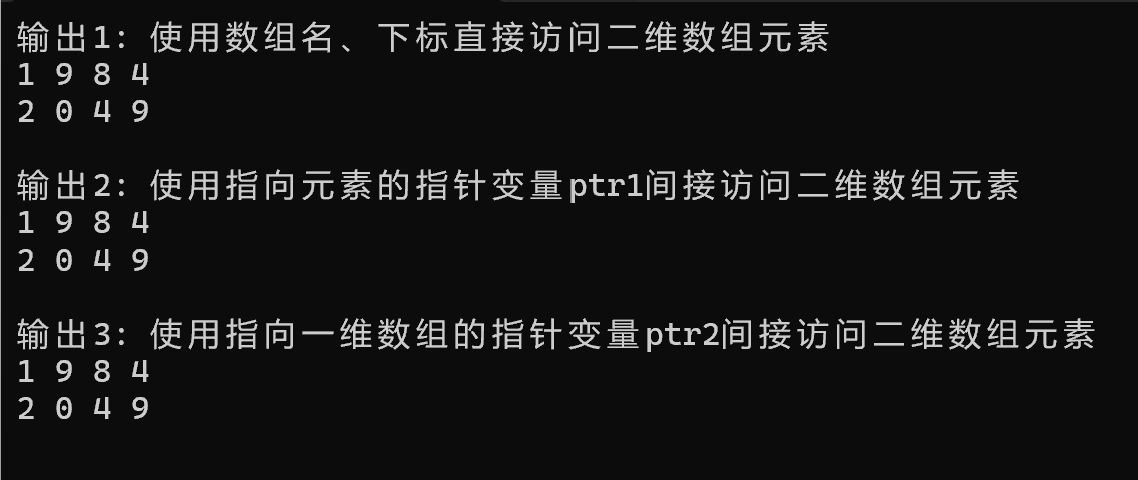
回答问题
int (*ptr)[4]; 中,标识符ptr表示的语义是指向一个含有5个整型数组的指针变量
int *ptr[4]; 中,标识符ptr表示的语义是一个含有5个指针变量的数组
task4_1
1 #include <stdio.h> 2 #define N 80 3 4 void replace(char *str, char old_char, char new_char); // 函数声明 5 6 int main() { 7 char text[N] = "c programming is difficult or not, it is a question."; 8 9 printf("原始文本: \n"); 10 printf("%s\n", text); 11 12 replace(text, 'i', '*'); // 函数调用 注意字符形参写法,单引号不能少 13 14 printf("处理后文本: \n"); 15 printf("%s\n", text); 16 17 return 0; 18 } 19 20 // 函数定义 21 void replace(char *str, char old_char, char new_char) { 22 int i; 23 24 while(*str) { 25 if(*str == old_char) 26 *str = new_char; 27 str++; 28 } 29 }

回答问题:
1. 函数 replace 的功能是将原始文本(字符串)中的相应字符以新字符替换
2. line24, 圆括号里循环条件可以改写成 *str != '\0' 。
task4_2
1 #include <stdio.h> 2 #define N 80 3 4 void str_trunc(char *str, char x); 5 6 int main() { 7 char str[N]; 8 char ch; 9 10 printf("输入字符串: "); 11 gets(str); 12 13 printf("输入一个字符: "); 14 ch = getchar(); 15 16 printf("截断处理...\n"); 17 str_trunc(str, ch); 18 19 printf("截断处理后的字符串: %s\n", str); 20 21 } 22 23 void str_trunc(char *str, char x) { 24 while(*str) { 25 if(*str == x) 26 *str='\0'; // blank1 27 28 str++; // blank2 29 } 30 31 //return; // blank3 32 }


task5_1
1 #include <stdio.h> 2 #include <string.h> 3 void sort(char *name[], int n); 4 5 int main() { 6 char *course[4] = {"C Program", 7 "C++ Object Oriented Program", 8 "Operating System", 9 "Data Structure and Algorithms"}; 10 int i; 11 12 sort(course, 4); 13 14 for (i = 0; i < 4; i++) 15 printf("%s\n", course[i]); 16 17 return 0; 18 } 19 20 void sort(char *name[], int n) { 21 int i, j; 22 char *tmp; 23 24 for (i = 0; i < n - 1; ++i) 25 for (j = 0; j < n - 1 - i; ++j) 26 if (strcmp(name[j], name[j + 1]) > 0) { 27 tmp = name[j]; 28 name[j] = name[j + 1]; 29 name[j + 1] = tmp; 30 } 31 }
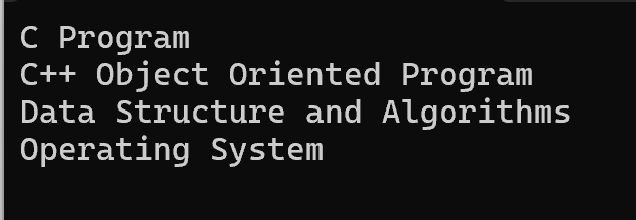
task5_2
1 #include <stdio.h> 2 #include <string.h> 3 void sort(char *name[], int n); 4 5 int main() { 6 char *course[4] = {"C Program", 7 "C++ Object Oriented Program", 8 "Operating System", 9 "Data Structure and Algorithms"}; 10 int i; 11 12 sort(course, 4); 13 for (i = 0; i < 4; i++) 14 printf("%s\n", course[i]); 15 16 return 0; 17 } 18 19 void sort(char *name[], int n) { 20 int i, j, k; 21 char *tmp; 22 23 for (i = 0; i < n - 1; i++) { 24 k = i; 25 for (j = i + 1; j < n; j++) 26 if (strcmp(name[j], name[k]) < 0) 27 k = j; 28 29 if (k != i) { 30 tmp = name[i]; 31 name[i] = name[k]; 32 name[k] = tmp; 33 } 34 } 35 }
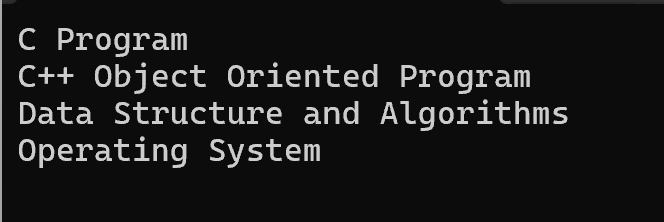
回答问题
这两种算法实现中,task5_1是内存中字符串的存储位置发生了交换;task5_2是交换的是指针变量的值
task6
1 #include <stdio.h> 2 #include <string.h> 3 #define N 6 4 5 int check_id(char *str); // 函数声明 6 7 int main() { 8 char *pid[N] = {"31010120000721656X", 9 "330106199609203301", 10 "53010220051126571", 11 "510104199211197977", 12 "53010220051126133Y", 13 "5301022Y0051126133"}; 14 int i; 15 16 for (i = 0; i < N; ++i) 17 if (check_id(pid[i])) // 函数调用 18 printf("%s\tTrue\n", pid[i]); 19 else 20 printf("%s\tFalse\n", pid[i]); 21 22 return 0; 23 } 24 25 // 函数定义 26 // 功能: 检查指针str指向的身份证号码串形式上是否合法。 27 // 形式合法,返回1,否则,返回0 28 int check_id(char *str) { 29 // 补足函数实现 30 if(!(strlen(str)==18)) 31 return 0; 32 while(*(str-1)){ 33 if(!(*str>='0' && *str<='9')) 34 return 0; 35 str++; 36 } 37 while(*str){ 38 if(!(*str>='0' && *str<='9' || *str=='X')) 39 return 0; 40 str++; 41 } 42 return 1; 43 }

task7
1 #include <stdio.h> 2 #define N 80 3 void encoder(char *str); // 函数声明 4 void decoder(char *str); // 函数声明 5 6 int main() { 7 char words[N]; 8 9 printf("输入英文文本: "); 10 gets(words); 11 12 printf("编码后的英文文本: "); 13 encoder(words); // 函数调用 14 printf("%s\n", words); 15 16 printf("对编码后的英文文本解码: "); 17 decoder(words); // 函数调用 18 printf("%s\n", words); 19 20 return 0; 21 } 22 23 /*函数定义 24 功能:对s指向的字符串进行编码处理 25 编码规则: 26 对于a~z或A~Z之间的字母字符,用其后的字符替换; 其中,z用a替换,Z用A替换 27 其它非字母字符,保持不变 28 */ 29 void encoder(char *str) { 30 // 补足函数实现 31 while(*str){ 32 if((*str>='a'&&*str<'z')||(*str>='A'&&*str<'Z')) 33 *str+=1; 34 else if(*str=='z'||*str=='Z') 35 *str-=25; 36 str++; 37 } 38 } 39 40 /*函数定义 41 功能:对s指向的字符串进行解码处理 42 解码规则: 43 对于a~z或A~Z之间的字母字符,用其前面的字符替换; 其中,a用z替换,A用Z替换 44 其它非字母字符,保持不变 45 */ 46 void decoder(char *str) { 47 // 补足函数实现 48 while(*str){ 49 if((*str>'a'&&*str<='z')||(*str>'A'&&*str<='Z')) 50 *str-=1; 51 else if(*str=='a'||*str=='A') 52 *str+=25; 53 str++; 54 } 55 }



实验总结
1.指针字符占用内存大小,一个指针即为占用一个字节,sizeof值为8
2.指针变量的值的交换与内存中字符串的存储位置发生交换的区别
3.字符进行数的加减运算进行简单移位操作





 浙公网安备 33010602011771号
浙公网安备 33010602011771号